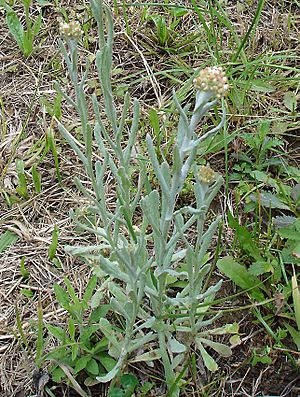Pseudognaphalium luteoalbum facts for kids
Quick facts for kids Pseudognaphalium luteoalbum |
|
|---|---|
 |
|
| Scientific classification | |
| Genus: |
Pseudognaphalium
|
| Species: |
luteoalbum
|
| Synonyms | |
|
Synonyms list
Dasyanthus conglobatus Bubani, nom. superfl. Filaginella luteoalba (L.) Opiz Gnaphalium alboluteum Roxb. Gnaphalium conglobatum Lam., nom. superfl. Gnaphalium depressum Steud., nom. superfl. Gnaphalium diffusum Baker Gnaphalium gracile Blume Gnaphalium javanum DC. Gnaphalium leontopodinum Bory ex DC. Gnaphalium luteoalbum L. Gnaphalium luteolum E.H.L.Krause Gnaphalium martabanicum Wall. Gnaphalium molle Salisb. Gnaphalium orixense Roxb. Gnaphalium pallidum Lam. Gnaphalium pompejanum Ten. Gnaphalium reinwardtianum Miq. Gnaphalium sphaericum Perr. ex DC. Gnaphalium trifidum Thunb. Helichrysum conglomeratum Moench Helichrysum luteoalbum (L.) Rchb. Laphangium luteoalbum (L.) Tzvelev Pseudognaphalium luteoalbum subsp. turcicum Yıld. |
|
This plant, known scientifically as Pseudognaphalium luteoalbum, is a type of flowering plant. It belongs to the Asteraceae family, which also includes sunflowers and daisies. In the United Kingdom, people often call it the Jersey cudweed. It has other scientific names too, like Helichrysum luteoalbum.
What it Looks Like
This plant grows straight up and can reach about 70 centimeters (27 inches) tall. It's a biennial plant, meaning it lives for two years. It grows new branches from its base.
Its leaves are shaped like a spoon or a spear. They are covered in soft hairs, much like the famous edelweiss flower. These special leaves can even survive freezing temperatures in winter.
The flowers of the Jersey cudweed can be cream, yellow, white, or pink. When the plant makes seeds, they have a fluffy part called a pappus. This pappus acts like a tiny parachute, helping the seeds float far away in the wind.
How it Got its Name
The famous scientist Carl Linnaeus first described this plant in 1753. He gave it the name Gnaphalium luteo-album. Later, the hyphen was removed from the name.
Over the years, scientists moved this plant into different groups. In 1829, Ludwig Reichenbach suggested putting it in the Helichrysum group. But this idea wasn't widely used at the time. The plant stayed in the Gnaphalium group until 1981. That's when two scientists, Olive Mary Hilliard and Brian Laurence Burtt, moved it to the Pseudognaphalium group.
The scientific name luteoalbum comes from botanical Latin. It means 'pale yellow', which describes the color of some of its flowers.
Where it Grows
This plant is found in so many places around the world that it's hard to tell where it originally came from. It's thought to be native to almost every continent except Antarctica. However, it has spread to North America and South America, where it is now considered naturalised. This means it grows there even though it didn't start there naturally.
You can find the Jersey cudweed growing in fields, empty lots, and at the edges of forests. Sometimes, its young leaves can look a bit like edelweiss, which can confuse people.
Uses of the Plant
In Vietnam, this plant is used in food. For example, it's an ingredient in a traditional rice cake called banh khuc.
People in that region have also used the Jersey cudweed in traditional medicine. It has been used to help with things like:
- Helping the body get rid of extra water (as a diuretic)
- Stopping bleeding (as a hemostatic)
- Reducing fever (as an antipyretic)
- Treating coughs
- Relieving pain
See also
 In Spanish: Pseudognaphalium luteoalbum para niños
In Spanish: Pseudognaphalium luteoalbum para niños
- Nanakusa-no-sekku

